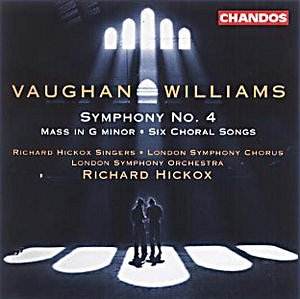Richard Hickox’s recording of the original version
of the London Symphony carried all before it last year, and there
is naturally a great feeling of expectancy at the arrival of this new
recording. The 4th Symphony is a very different animal from
the London of course. It is notoriously aggressive, often spilling
over into violence; "I’m not sure I like it but it’s what I meant"
VW famously commented at an early rehearsal. Writers have not been slow
to point out its historical context – the early ’30s, with the military
build-up in Germany and ever- increasing tension throughout Europe.
Yet the composer vigorously rejected this sort of facile interpretation,
and it seems likely that the anger in the work has at least as much
to do with Vaughan Williams’ personal and professional circumstances
as it has with wider political and social issues.
It’s easy to forget that VW was not a young man when
he composed this work; he was nearly sixty when it was completed. He
was aware, possibly uncomfortably so, of radical changes going on around
him in the musical world, and could be forgiven for, perhaps, not wanting
to get ‘left behind’. There was also a healthy bloody-mindedness about
him, and he will have relished throwing this work in the face of those
who had him down as a ruminative ‘cow-pat’ composer (Michael Kennedy
expands on this question in his booklet notes, touching on an interesting
new theory in the process).
The 4th is a stunning statement, a tightly
packed musical bombshell. The great early interpreter of the work, apart
from the composer himself, was Boult, and his fine version of the 1950s
takes its cue from the composer’s own recording of the work in going
for the jugular. In this he was helped by having the LPO at one of its
peaks, and a Decca recording which missed nothing yet produced superb
overall sound for its day.
I’m glad to say that Hickox takes the same no-holds-barred
approach as Boult. In place of Boult’s LPO, we have here the LSO in
superb form, and a Chandos 24-bit recording of the very highest quality.
Hickox takes the opening Allegro at a terrific pace – several
notches quicker, for example, than Andrew Davis in his rather polite
Teldec reading. Indeed, Hickox’s tempi for the quicker sections throughout
the work tend to be right on the edge, and wouldn’t be practicable without
a great orchestra to see him through. But the LSO rises to the task
magnificently, and there is fine playing from every section. Listen
to the pianissimo of the divided strings at the end of the first movement
– track 1 around 6:25 – meltingly beautiful yet uneasy and disturbing.
Brass tone is splendidly burnished, with a real edge to it when required.
The trombones’ announcement of the apocalyptic fugue-subject in the
finale is chilling, as is the response of the trumpets in the same place.
There are dozens of other examples of individual and collective brilliance
of execution.
In his excellent booklet notes, Michael Kennedy emphasises
the work’s superficial kinship with Beethoven’s 5th Symphony,
which is most obvious in the pianissimo-crescendo link between the Scherzo
and the Finale. This is the one place where I remain to be entirely
convinced by Hickox’s approach. Rather than go for real hushed mystery,
he keeps the tone level comparatively high, emphasising the threatening
rumbling in the basses. Surely though, this is the one moment in the
work where the violence needs to recede into the distance before bursting
out with renewed ferocity?
That small question-mark aside, this is a great achievement;
a concept of the work that sees it as a single, unified statement of
frightening intensity. At the end, I was left stunned – as one should
be – and the beginning of the Mass in g minor felt like walking from
the scene of some horrific disaster into a cool, peaceful chapel, which
is no doubt what was intended by the coupling. The modal opening theme
of the Mass falls on the ears like balm after the relentless dissonance
of the symphony, and is given a very beautiful performance by Hickox
and his Singers. It does seem bit mean, though, that Chandos have not
chosen to credit the four soloists, whose music is such an important
part of this exquisite work.
The disc is completed by a most welcome rarity, the
Six Choral Songs in Time of War. These are sturdy, relatively
straightforward unison settings of inspirational words by Shelley. They
demonstrate one of the most wonderful things about VW; whether it was
a huge symphony or a much simpler work like this, he put everything
he had into it. These songs, sung with fine tone and real feeling by
the LSC, make an ideal foil to the other two works. It also means that,
in this disc, you have a remarkable picture of the breadth of Vaughan
Williams’ vision – from the shattering aggression of the symphony, via
the spirituality of the Mass, to the honest populism of the concluding
Songs.
Those who have been waiting with bated breath for this
issue are not going to be disappointed in any way – hurry, hurry, hurry!
Gwyn Parry-Jones


